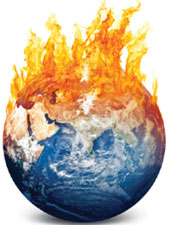sierraclub.org - sierra magazine - march/april 2009 - hot off the press


Hot Off the Press!
Global Warming, Natural Hazards, and Emergency Management was coauthored by Kim Haddow, the Sierra Club's national communications director; Jane Bullock, who served as FEMA's chief of staff; and George Haddow, FEMA's deputy chief of staff during the Clinton administration.
 The Obama administration could not be clearer about its commitment to fighting climate change. The creation of the new position of assistant to the president for energy and climate change and the fact that Secretary of State Hillary Clinton's first trip abroad will be to China to discuss climate change leave no doubt the administration is approaching the problem with seriousness and urgency.
The Obama administration could not be clearer about its commitment to fighting climate change. The creation of the new position of assistant to the president for energy and climate change and the fact that Secretary of State Hillary Clinton's first trip abroad will be to China to discuss climate change leave no doubt the administration is approaching the problem with seriousness and urgency.
But now that we are poised to make progress, the public is backpedaling. Polls show the issue is declining as a priority, and a larger percentage of Americans now believe global warming is part of a natural cycle (and not human-caused) than did two years ago. Blame the economy, which today trumps every other concern, or the increased politicization of the issue (the attitudes of Democrats and Republicans vary widely). But part of the explanation lies in the public's continued perception that global warming is just too overwhelming and complicated a problem to solve--especially given the fact that to fix it we must address its causes and effects simultaneously.
Cutting the carbon emissions that are raising the earth's temperature is only part of the answer. We must also help people, communities, and environments survive a climate that will continue to change for at least the next sixty years because of emissions already in the atmosphere, with more frequent and intense storms; an increase in the number and range of floods, droughts, and wildfires; and rising sea levels on America's coasts.
The good news is that communities are acting now to reduce their risks, to save lives and businesses, to survive and even thrive in a changing climate. It's a story that's told in the book Global Warming, Natural Hazards, and Emergency Management, a collection of case histories and procedural road maps for community preparedness based on three foundational principles:
- Protecting nature protects people. Wetlands, forests, and barrier islands are the first line of defense against natural disasters, serving as wind buffers and storm water sponges. Preserving and restoring these ecosystems will make communities safer and more resilient.
- Reducing risks before disaster strikes saves lives and money.
- Local communities have a large and unique role in reducing the risks of natural disasters.
The book highlights the risk-reduction efforts of communities across the United States, including:
- Napa Valley, California, where a community coalition that included the Army Corps of Engineers came together to create and implement a plan that reduced flooding, protected the Napa River, and revitalized the downtown economy;
- Sawmill Gulch, Montana, where, as told by former Sierra Club staffer Kathryn Hohmann, an unlikely partnership between the U.S. Forest Service, environmentalists, and timber companies developed to reduce the community's risk of wildfires;
- Freeport, New York, where roads and railroads grades have been raised to avoid flooding;
- Tulsa, Oklahoma, where a private-public partnership is working to protect people from tornadoes.
In community after community, solutions to natural disasters that will be worsened by climate change have taken root. These stories of creative and collaborative problem solving need to be shared with the American public to start to ease their fears and spark their participation in protecting and preparing their communities and environment for climate change.